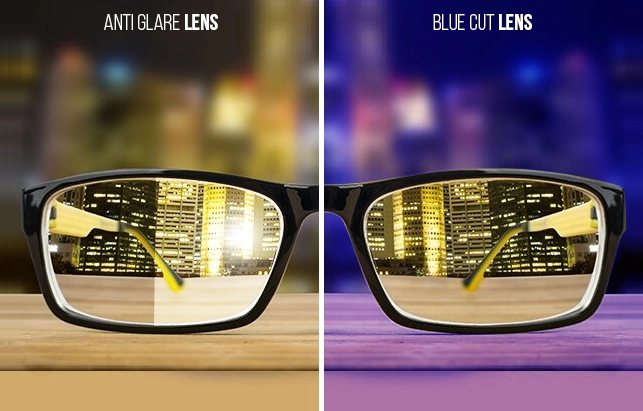BLUE CUT LENSES
Blue-cut lenses are designed to absorb anywhere from 10% to over 90% of blue light. Blue light is visible light with high energy in the range of 380 nanometers to 495 nanometers. This type of lens is designed to allow some blue light to pass through to prevent color distortion. The amount of color distortion may increase with lenses that are designed to block more than 50% or 60% of blue light from passing through to your eyes.

Anti-blue light glasses can immediately reduce symptoms of digital eye strain, especially when working at night. Over time, wearing blue blockers while working on digital devices may help to normalize your circadian rhythm and risk of macular degeneration.
3. Lenses May Be Coated or Infused
Anti-reflective lenses almost always have a hard coating on both sides of the lens. This coating is most necessary for lens materials that have a high index of refraction, as these lenses reflect more light than plastic lenses.Blue cut lenses may feature layered substrates or blue light blocking coatings, depending on the brand. Some blue-light-blocking lenses are infused with melanin, which filters out up to 98% of blue light. Progressive glasses made with this substance, which naturally occurs in the skin, may have a brownish-yellow tint.Depending on whether optic clarity or color accuracy is the deciding factor, you may prefer to order glasses with either anti-glare or blue-cut lenses. Choose lenses with an anti-reflective coating if you want to see more clearly and reduce eye strain. If blocking more of the blue light that emanates from backlit digital devices is your top priority, anti-blue light glasses are the best choice.
3 Differences Between Anti-Glare and Blue Cut Lenses FAQs
Is It Easy To Find Prescription Blue Light Glasses?
You can easily find the right prescription blue light glasses to fit your needs. Check out the selection available at Marvel Optics, find a style that you love, and place your order. You’ll soon be ready to shield your eyes from harmful blue UV rays.
What Does Anti-Glare Treatment Do?
Anti glare glasses are meant to reduce the amount of glare that a person experiences while wearing his or her glasses. This can be beneficial to anyone who spends a lot of time outdoors or in bright environments, as the glare can cause problems with being able to see clearly.
What Is Polarization?
Slightly different than traditional anti glare glasses, polarization is a treatment that can help with a different type of glare. When light hits surfaces like glass or water, it creates an intense reflection that can cause vision troubles. Polarization cuts through this glare and improves your ability to see in bright environments.
Does Anti-Glare Block Blue Light?
Unfortunately, glasses with anti-glare lenses are not typically crafted to block blue light. If you’re looking for eyewear that will help you with this particular problem, you should look into your options with blue light filter glasses. Glasses designed to block blue light will help whenever you’re using digital devices.
Can Anti-Glare Coating Increase Scratches?
In some cases, anti glare glasses using specific treatments have been known to increase the risk of scratches. The best way to avoid this is follow the right safety precautions. Always keep your glasses in a case and be sure to wipe it free of dust and debris using an appropriate cloth. Be gentle with your eyewear and your glasses are bound to last you a long while.
